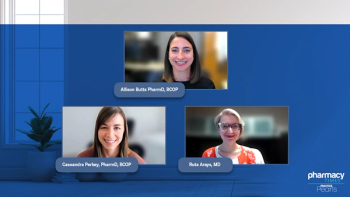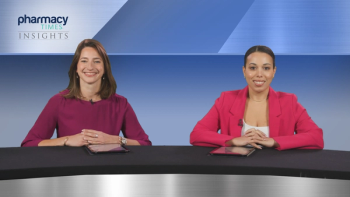
Optimizing The Impact of BTK Inhibitors
Drs Haumschild, Jain, and Wang discuss clinical pearls regarding BTK inhibitors, including drug interactions.
Episodes in this series

Ryan Haumschild, PharmD, MS, MBA: When we think about BTK [Bruton tyrosine kinase] inhibitors as a whole, there are some clinical pearls and takeaways. As a pharmacist who leads an entire pharmacy department, I usually think of some drug interactions that we constantly need to be looking at. If a patient might be on a gastric-reducing therapy, how is that going to interact? If a patient has a fungal infection and is on an azole, how is that going to interact with BTK inhibitors? When we focus on those, what are some key pearls that you have for our viewers in terms of efficacy, resistance, intolerance, or any type of dosing or adherence that you’ve seen from your real-world practice?
Preetesh Jain, MBBS, MD, DM, PhD: That’s very important, because many of these cardiac arrhythmia drugs that many older patients take—like amiodarone, and anticoagulation, like warfarin or omeprazole—are the common drugs that patients use when you look at their medication history. These drugs can influence the adverse events and increase the levels of BTK inhibitors in the blood, which can increase the risk of toxicity, so we avoid the concurrent administration of these drugs with BTK inhibitors, most commonly ibrutinib. With acalabrutinib and zanubrutinib, we’re noticing that these patients can also have interactions, so we change the medication to an alternative H2-blocker agent. This problem isn’t as common with pirtobrutinib because there aren’t any data that pirtobrutinib, the newer BTK inhibitor, can influence that. But we do that stratification.
The second thing is about the antifungal agents, which is very important: azoles vs nonazoles. With the azole group, if the patient is taking posaconazole or fluconazole with these, then we have to change it to isoconazole or space out the duration of administration about 6 hours after taking the antifungal medication. Those are the some of the adjustments we make.
Michael Wang, MD: There are some specific things to pay attention to. If a patient already has a history of atrial fibrillation or paroxysmal atrial fibrillation, we avoid ibrutinib. If a patient is young and has a history of migraine, acalabrutinib is the only BTK inhibitor that’s associated with headache. We’ll be very careful with a young patient with a history of migraine.
With covalent BTK inhibitors, before, some of the patients with mantle cell lymphoma would have lymphoma cells in the peripheral blood. If you give them covalent BTK inhibitors, they’d have phenomena where the lymphocytosis will increase before it decreases. Sometimes we have to be aware of the blood viscosity and the risk for DVT [deep vein thrombosis] and tumor lysis. Pirtobrutinib doesn’t have this. But pirtobrutinib is still an early drug with few years of follow-up time, so we’ll continue to pay attention to the adverse effect profile along with more people treated with longer follow-up time.
Ryan Haumschild, PharmD, MS, MBA: When we think about adverse effects and treatments, 1 thing I like is leveraging real-world evidence. Ibrutinib and some of these have been on the market a little longer. There has been higher utilization in the past, but these next-generation BTK inhibitors offer a lot of advantages for patients. We’ve gone through those. We don’t need to rehash too much.
Dr Jain, you and Dr Constantine Tam and others are bringing a lot of literature to the forefront as clinicians are trying to decide. When I interact with providers who might be in the community setting or might be more familiar with some of the first-generation BTK inhibitors, there are some differences between the next generation and the first generation. Some of that has to do with the pharmacokinetics that we think about quite often. Sometimes it’s the drug-drug interactions of statins and zanubrutinib. Or its the ease of use, whether a patient has to take it with or without food. When you want to break this down to people who are helping influence treatment decisions or management, what are some of the key differences that you’d like to call out between the first- and next-generation BTK inhibitors?
Preetesh Jain, MBBS, MD, DM, PhD: Those are very important and practical questions that patients ask on a day-to-day basis. As Dr Wang mentioned, you have to look at the particular BTK inhibitor to see whether it’s going to be suitable for a patient. For example, when a patient has a significant history of cardiac issues or cardiac arrhythmias, we’d be very careful about giving ibrutinib by discussing it with the cardiologist. We’d look into administration of acalabrutinib or zanubrutinib for those patients.
If a patient has a previous history of migraine, as Dr Wang suggested, then because the most common adverse effect of acalabrutinib is headache, we’d clearly stratify and discuss this with the patient and observe and monitor. If the patient has a GI [gastrointestinal] history, diabetic history, or a history of diarrhea or some other GI malabsorption syndrome, we’d look to avoid zanubrutinib because that more commonly has a tendency to cause GI upset. If a patient has a bleeding or coagulation tendency, a protein C or protein S deficiency, or they’re already on multiple anticoagulants, then with all 3, we’d look at the risk and benefit or dose reduce or change to a direct-acting oral anticoagulant or space out the administration of the drug.
The second-generation BTK inhibitors have a much more favorable profile compared with ibrutinib. The incidence of major bleeding is also being reported with ibrutinib. If the patient is on azoles or has a previous long-term administration of ibrutinib, that’s also reported to induce the risk of CNS [central nervous system] aspergillosis or high risk of aspergillosis, but it isn’t as reported with acalabrutinib and zanubrutinib. In that situation, if your patient has a previous history of recurrent fungal infection, you’d lean more toward the next-generation BTK inhibitors.
Michael Wang, MD: Ryan, as a PharmD and a leader in the field, you can give an even better profile on BTK inhibitors, their drug problems, and so forth.
Ryan Haumschild, PharmD, MS, MBA: I agree with what Dr Jain said. You have to be patient specific. Is the patient on corticosteroids? Could they potentially have had a fungal infection in the past? Is that something I need to consider when treating with this medication? I like looking at the pathophysiology and thinking about the cardiac history and how that’s going to come into play with these patients. Typically, is that something I need to be concerned about? If it is, I need to [adjust the] dose or select our therapy appropriately on the front end. At the same time, if any therapies can be modified, I want to do that as part of that patient’s plan and reach out to that primary care provider who started that therapy.
Those are some of the unique things I consider when it comes to adverse effects. When there’s mechanism of action, I also want to think about what the resistance is going to be like with these BTK inhibitors and how mutations come into play. That’s the next step as we’re selecting therapy. Third, agnostic of all the clinical criteria, which are extremely important, I want to make sure our patient is going to adhere to the therapy. If there are any cytochrome P450s or inducers that patient is on, I want to be very thoughtful about that to make sure that I’ll get them on the right therapy and they’ll be able to maintain that therapy through that duration of therapy.
Many times, the frustration for me as a PharmD and someone who’s treating patients is when a patient abandons therapy too soon, or for some reason has any rate-limiting adverse effects and we haven’t done anything to dose modify that patient or at least intervene early on. That’s where I feel my role or the pharmacists’ roles comes into play—team-based care, where we’re complementing the great therapeutic decisions that you and Dr Jain are making and we’re helping make it patient specific. We’re educating them. We’re anticipating any changes in therapy or adverse effects and providing early intervention.
Transcript edited for clarity.
Newsletter
Stay informed on drug updates, treatment guidelines, and pharmacy practice trends—subscribe to Pharmacy Times for weekly clinical insights.






















































































































































































































